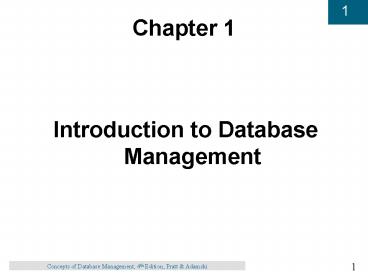Introduction to Database Management - PowerPoint PPT Presentation
1 / 30
Title:
Introduction to Database Management
Description:
Association between entities. Rep is related to many customers ... One-to-Many Relationship. Figure 1.4. 11. 1 ... Book store chain operated by Ray Henry ... – PowerPoint PPT presentation
Number of Views:31
Avg rating:3.0/5.0
Title: Introduction to Database Management
1
Chapter 1
- Introduction to Database Management
2
Objectives
- Introduce Premiere Products, the company that is
used as the basis for many of the examples
throughout the text - Introduce basic database terminology
- Describe database management systems
- Explain the advantages and disadvantages of
database processing - Introduce Henry Books, the company that is used
in the case that runs throughout the text
3
Premiere Products
- Distributor of appliances, housewares, and
sporting goods - Uses spreadsheet software to maintain important
data - Recent growth has made the spreadsheet approach
problematic - Redundancy
- Difficulty accessing data
- Limited security
- Size limitations
4
Premiere Products Required Information
- Sales Reps
- Sales rep number, last name, first name, address,
total commission, commission rate - Customers
- Customer number, name, address, current balance,
credit limit, customer sales rep - Parts Inventory
- Part number, description, number units on hand,
item class, warehouse number, unit price
5
Premiere Products Sample Order Figure 1.2
6
Premiere Products Customer Order
- Order
- Order number, order date, customer number
- Order line
- Order number, part number, number units ordered,
unit price - Overall order total
- Not stored since it can be calculated
7
Database Background
- Database
- Structure to store information about multiple
types of entities, attributes, and relationships - Entity
- Person, place, thing, or event
- Premiere Products has sales reps, customers,
orders, and parts - Attribute
- Property of an entity
- Customer has name, street, city, et cetera
8
Entities and Attributes Figure 1.3
9
Database Background (cont.)
- Relationship
- Association between entities
- Rep is related to many customers
- Customer is related to a single rep
- Data file
- File used to store data
- Computer counterpart to ordinary paper file
10
One-to-Many Relationship Figure 1.4
11
Rep and Customer Tables Figure 1.5
12
Orders and OrderLine Tables Figure 1.5 (cont.)
13
Part Table Figure 1.5 (cont.)
14
Alternative Orders Table Figure 1.6
15
Database Management Systems
- Program(s) through which users interact with
database - Popular DBMSs include Access, Oracle, DB2, SQL
Server - Premiere Products decides to use Access
16
Using DBMSs in Different Ways Figures 1.7 and 1.8
17
Building a Database
- Database design determines the structure of a
database - Design entered into DBMS during Construction
- Tables
- Forms
- Reports
- Switchboards
18
Part and Order Forms Figures 1.9 and 1.10
19
Parts Report Figure 1.11
20
Switchboards Figure 1.12
21
Switchboards (cont.) Figure 1.13
22
Advantages of Database Processing Figure 1.14
23
Disadvantages of Database Processing Figure 1.15
24
Introduction to Henry Books Database Case
- Book store chain operated by Ray Henry
- Henry decided to use database to gather and store
information on - Branches
- Publishers
- Authors
- Books
25
Sample Branch Data Figure 1.16
26
Sample Publisher Data Figure 1.16 (cont.)
27
Sample Author Data Figure 1.17
28
Sample Book Data Figure 1.18
29
Wrote Table Relates Authors to Books Figure 1.19
30
Inventory Table Relates Branches to Books Figure
1.19 (cont.)































